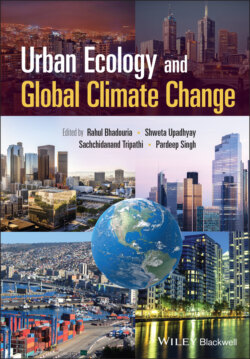Читать книгу Urban Ecology and Global Climate Change - Группа авторов - Страница 19
1.2.2 Urban Vegetation
ОглавлениеUrbanisation provides a unique habitat for vegetation growth. Urban vegetation (tree, shrub, or ornamental plants) is comprised of both native and exotic species (Cubino et al. 2021). Two major processes are involved in the growth of urban vegetation, viz. cultivated vegetation growth which represents the plants that are introduced and managed by the urban inhabitants, and spontaneous vegetation growth which have been established and colonised without the human‐assistance (Cubino et al. 2021). Vegetation composition of the urban areas even differs at small scales depending on the several social factors (Čeplová et al. 2017). Introduction and cultivation of plants, especially ornamental or exotic plants for their aesthetic values by the urban inhabitants hold a crucial significance in current scenario. Exotic plants constitute a major portion of the urban vegetation; however, their contribution to the functioning and diversity at the socio‐ecological scales have been less explored (Cook‐Patton and Agrawal 2014; Pearse et al. 2018; Cubino et al. 2021). Most of the exotic species present in the urban areas are ornamental plants introduced intentionally by the humans (Čeplová et al. 2017; Lososová et al. 2018). Due to suitable environmental (heterogeneous) conditions or positive anthropogenic interferences (fertilisation and irrigation at regular intervals) in the urban areas, exotic plants have substantial scope to establish and colonise (Lososová et al. 2018). Human‐induced dispersal of the plant species in the urban areas contributes to the plant distribution and community composition (Møller et al. 2012; Lososová et al. 2018). Moreover, local fauna and their preferences for the fruits/flowers also contribute to the biodiversity of the area. For example, the preference of frugivorous birds affects the dispersal of fleshy‐fruited plant species in the urban areas (Møller et al. 2012). Moreover, birds help in seed dispersal of ornamental (exotic) trees from the gardens to the nearby natural ecosystems, thus, may facilitate plant invasion (Milton et al. 2007). Thus, exotic plants can be a major cause of ecosystem imbalances when the sufficient source of seeds/propagules and its dispersal agents are present in the nearby areas (Rai and Kim 2019).
Vegetation, particularly trees, plays a crucial role in maintaining the harmony in the urban ecosystems (Tigges et al. 2013). For example, trees store sufficient amount of carbon (C) and help in maintaining the overall C‐pool of the urban ecosystems (Davies et al. 2011). Urban ecosystems have sufficient potential to store C in their above‐ and belowground components (Hutyra et al. 2011; Nowak et al. 2013), even in dense urban areas (Mitchell et al. 2018). Urban areas have abundant shade trees (recreational purpose), trees grown for hazard removal, or exotic trees, all have potential to store substantial amount of C in their vertical structures. However, C‐density of the urban areas varies at spatio‐temporal scales (Mitchell et al. 2018; Upadhyay et al. 2021). Detailed view on the urban C‐stocks and their ecosystem services have been highlighted in the latter part of the chapter.
